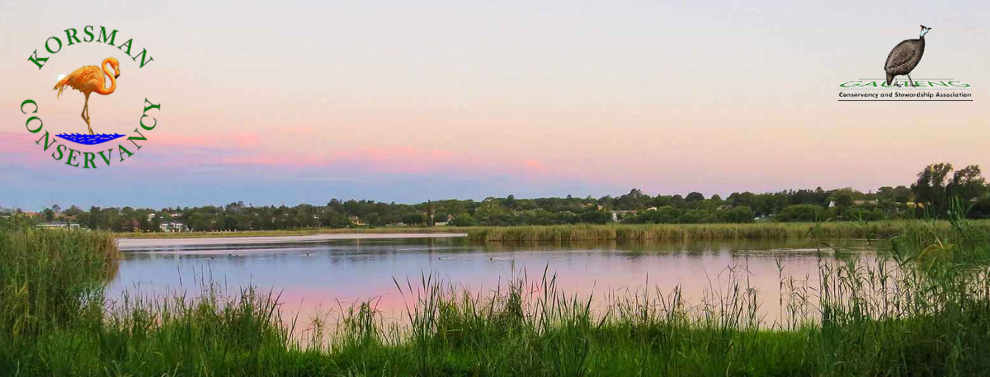
KORSMAN CONSERVANCY
Invasive Plants and Removal Methods
PRESENT STATUS
Control phase - Drastic reduction of existing population:
Spear Thistle (Cirsium vulgare), Jerusalem cherry (Solanum pseudocapsicum) Purple Top (Verbena Bonariensis) Moth catcher vine (Araujia sericifera) Weeping Willow (Salix Babylonica) Black Locust (Robinia pseudoacacia)
Follow-up phase - Control of seedlings, root suckers and coppice growth (no plants go to seed):
Pompom weed (Campuloclinium macrocephalum) through continuous monitoring and immediate removal of isolated plants.
Red sesbania (Sesbania punicea) - seedlings removed while small.
Bugweed (Solanum mauritamium) - seedlings removed before going to seed.
Ongoing Threats
Kikuyu has the potential to overwhelm indigenous grassland. Current management is spraying followed by controlled burning.
Common Reed (Phragmites Australis) and Bulrush (Typha Capensis) have spread due to high water levels and nutrient-rich water from sewerage spills.
Uncategorised alien trees and weeds which have become locally invasive: American Ash (Fraxinus americana), Chinese Elm (Ulmus parvifolia) and Chinese Maple (Acer buergeranium) Fleabane (Erigeron bonariensis)
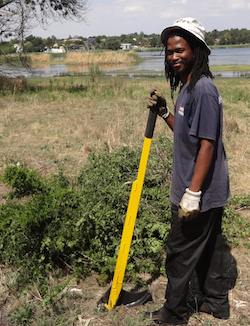
Manual methods
Tree Popping
For saplings not propagated by runner, ie. American Ash, Chinese Elm, Chinese Maple, Privet, Chinese Stinkwood.
Weeding and slashing
Regular inspection from spring until autumn.
Spear Thistle - October to May. Dig out before flowering, otherwise cut and bag flowers. Consistent effort has dramatically reduced the infestation.
Pompom weed - inspect from summer onwards. Dig out bulbous roots. Flower heads must be removed and bagged.
Moth catcher - remove as much root as possible. Fast grower! Do not allow to bear fruit.
Fleabane - pull out from December onwards. Don't break it off - remove the crown at least. Not categorised as invasive but has the potential to overwhelm grassland at Korsman.
Blackjacks - slash large areas before seeding. Several treatments may be needed per season, depending on rainfall and growth. January-May.
Curly Dock - slash plants while flowering to prevent seed maturing.
Below: Spear Thistle - taller than the volunteer who dug it out
Use of herbicides
Herbicides are a necessary evil to combat certain species and are frequently used in conjunction with manual methods in the most responsible way.
Imazapyr is used to treat woody plants and is environmentally safer for water but binds to soil, so avoid spills.
Triclopyr is effective on leguminous species (Black locust) but not water-safe. Keep away from water, do not use if rain forecast within two days
Glyphosate - For reeds and bulrushes in water, Kilo Max brand is water-safe as it does not have surfactants, which are far more poisonous to fish than the herbicide.
Tree Felling / Lopping and Stump Painting
Many trees coppice after cutting, so the stumps must be properly treated. Paint stump within seconds of tree being cut, especially around bark line. Follow up with lopping of regrowth.
Foliar Spraying
Grasses: Kikuyu sprayed with glyphosate. Pampas grass has been eradicated by glyphosate spraying by Ekurhuleni.
Black Locust: spray with triclopyr when approx 50cm high. Monitor for resprouting after fire.
Common reed (Phragmites Australis) and Bulrush (Typha capensis) managed by slashing, then spraying regrowth between November and March with water-safe glyphosate (Kilo Max). Ongoing follow-up required.
Ring barking / bark peeling has been successful on Australian Blackwood, with a backup application of triclopyr.
Bark peeling unsuccessful on American Ash (resprouted from roots.).
Controlled Burning to remove sprayed kikuyu and stimulate indigenous growth. See Ecological Burning Plan
Burning is an essential aspect of veld management, but challenges at Korsman are:
- Urban area
- Proximity of fence
- Proximity of reed beds
Biocontrol: During the Red Water Fern (Azolla filiculoides) infestation in 2014, we tried to source Frond Feeding Weevil but the program has been so successful in South Africa that none was available. The infestation abated during 2015, as weevils possibly arrived on their own.
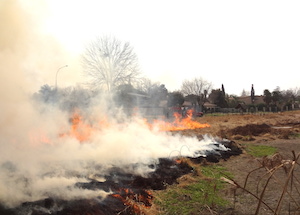
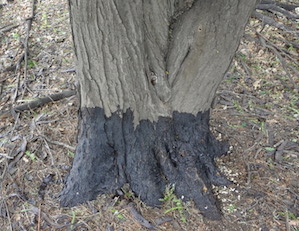
Korsman Conservancy 2018 Invasive Species Control and Management Plan as required by Section 76 of NEMBA
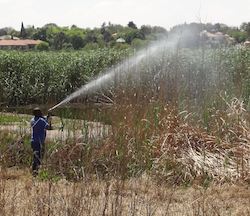
Basal Bark Treatment
Mix triclopyr with diesel and apply to bottom 30cm of bark above ground.
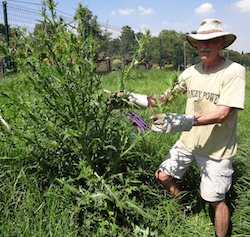
Stem injection for trees
Drill downward angled holes 20cm apart with awl and inject immediately with undiluted imazapyr (non-leguminous trees) or triclopyr (leguminous such as Black Locust)
Stem injection has been most effective on soft-wooded trees Salix Babylonica and Populus Deltoides (Cottonwood).
This allows trees to be killed and left standing to provide habitat for birds.
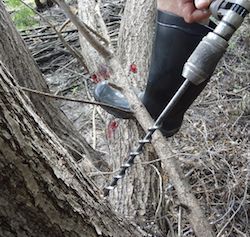
web hosting kindly donated by


